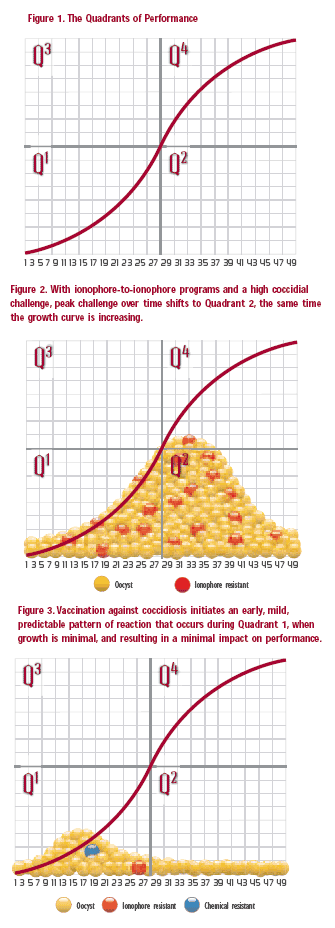What quadrant are you in?
Veterinarians present a visual guide to managing coccidiosis and plotting your success.
You've been successfully using
ionophores to control coccidiosis,
but lately performance in
your broilers just doesn't seem as good
as it used to be. You want to try switching
to a new program, but can't decide
whether to try a chemical-to-ionophore
shuttle or a few rounds of coccidiosis
vaccination.
How will you know what to expect
with different programs? And how can
you get the best coccidiosis control as
well as optimum growth in birds?
A new concept known as the
Quadrants of Performance may be
just what you need to understand
and help predict the impact of various
anticoccidial strategies on broiler
performance.
"The Quadrants of Performance
concept is a visual tool demonstrating
the effects of anticoccidial control programs
and a pathway for achieving
improved outcome and cost effectiveness,"
says Dr. Charlie Broussard, director
of global technical services for the
Schering-Plough Animal Health
Corporation's Poultry Business Unit.
Developed by coccidiosis specialists
at Schering-Plough Animal Health, the
concept is based on published and
non-published work on oocyst cycling
in chickens, as well as the company's
extensive worldwide experience managing
coccidiosis, the costly protozoan
disease that threatens commercial poultry
operations worldwide, he says.
Basic graph
The Quadrants of Performance concept starts with a basic graph that plots two major thresholds (Figure 1):
- Level of infection, illustrated by a horizontal line
- Age of infection, illustrated by a vertical line
"The basic graph is then used to illustrate the process of various anticoccidial programs," Broussard says. "We have plotted real-world experience and feel confident that the Quadrants provide a good approximation of what to expect with each type of anticoccidial program. It takes a lot of guesswork out of anticoccidial control."
The Quadrants of Performance concept is based on the premise that, at some point during coccidial exposure, there is an age threshold that affects performance markers such as feed conversion, weight gain, caloric conversion, thriftiness and mortality.
During Quadrant 1, for example, when growth is slower, the impact of coccidial exposure is minimal. "Quadrant 1 is a time of early, slower growth with coccidial challenge that is below the horizontal threshold, so the impact on performance is minimal," Broussard says.
 |
"A coccidial challenge in Quadrants
2 or 4 is quite another matter," he says,
"because these are times of rapid
growth and a coccidial challenge can
seriously impair the growth rate."
The worst-case scenario is a coccidial
challenge during Quadrant 4,
when the growth curve is strong.
"You're to the right of the vertical
threshold and above the horizontal
threshold," Broussard says.
Not just a 'pass/fail' grade
Poultry veterinarian Dr. Linnea
Newman, a consultant for Schering-
Plough Animal Health, says the
Quadrants concept encourages poultry
integrators to examine how their current
coccidiosis control program interacts
with the broiler growth curve.
"As things are now, the industry
thinks of coccidiosis control in terms of
a simple pass/fail grade. Each week,
feed conversion is assessed and a conclusion
is made about whether the
program is either working or not. This
approach can lead to knee-jerk program
changes when performance
slips," she says.
The Quadrants concept goes
beyond the simple "pass/fail" system. It
considers when coccidiosis control has
an effect on the growth curve. "You can
have an overall passing grade on total
coccidiosis control but could actually
be leaving dollars on the table because
your passing grade is really only a C+,"
she says.
In addition, the Quadrants concept
encourages integrators to look at how
performance in today's flock affects
subsequent flocks and to aim for a
solid grade "A" performance, Newman
says.
Ionophore programs
As an example, Broussard cites experience
with ionophores, which rely on
oocyst "leakage" to stimulate the chicken's
immune system against coccidial
challenge. In situations where there is a
high coccidial challenge as determined
by the oocyst litter count and intestinal
lesions, the peak challenge shifts with
time to Quadrant 2, the same time
when the growth curve and opportunity
for maximal meat production is
increasing. (See Figure 2.)
Continued use of ionophores can
result in the selection of ionophore-tolerant
coccidial strains, which make the
anticoccidial program less effective.
"Increased oocyst leakage can compromise
the next flock through heavy
carry-over of sporulated oocysts.
Ionophore-tolerant coccidia strains may
become hard to control, resulting in
poor feed conversion and weight gain
and increased production costs," he
says.
Ionophores on farms with a low
coccidial challenge result in slow
development of coccidial immunity,
Broussard says. Initially, results may be
satisfactory if the coccidial challenge
remains low but, with time, the peak
challenge shifts to Quadrants 2, 3 and 4, resulting in ionophore-tolerant coccidial
strains and a less effective anticoccidial
program.
"Continuous oocyst leakage can
slowly increase the number of oocysts
carried over to future flocks, and it's
not uncommon in these situations to
see performance slowly deteriorate.
You may not even realize it's happening
but, eventually, production costs
start creeping up as the peak oocyst
challenge shifts to Quadrants 2, 3 and
4," he says.
Newman agrees and says, "High
oocyst numbers at the end of one flock
means that the next flock will have a
bigger coccidiosis challenge and more
resistant oocysts challenging the next
coccidiosis control program.
"If I have 10% resistant oocysts, and
I carry over 100 oocysts, it means that I
have a grand total of 10 resistant
oocysts in my house. If I have the same
10% resistant oocysts and I carry over
100,000 oocysts per gram of litter to the
next flock, I have 10,000 resistant
oocysts per gram of litter. That's a big
challenge to the next program and contributes
to program failures."
Chemical and ionophore programs
The course of events is similar with
chemical-to-ionophore programs,
Broussard says. When anticoccidial
chemicals are used in the starter feed,
oocyst shedding is pushed to Quadrant
2, that critical growth period.
Ionophore leakage may allow the number
of chemical-resistant coccidia to
grow. High numbers of residual
oocysts challenge the efficacy of the
ionophore starter in the next rotation.
With chemical-to-chemical programs,
the situation changes somewhat.
Initially, chemical anticoccidials
appear to be very effective. They shut
down oocyst shedding in the house
and reduce peak coccidial challenge to
very low levels during Quadrant 1. But
drug resistance can build up fast and
shift the peak oocyst challenge to
Quadrant 3, due to a quick selection of
strains that are resistant to chemical
anticoccidials.
"Initially, we see dramatic improvement
in performance after switching
from straight ionophore programs to
a chemical-to-chemical program,"
Broussard says. "But then drug resistance
appears after one or two growouts,
and clinical coccidiosis results.
Flock performance is compromised
and production costs rise."
"We have learned that if you're in
Quadrant 2, 3 or 4, performance may
be suffering either slightly or severely,
and changes need to be made," he
says.
Coccidiosis vaccination
Experience in the field with coccidiosis
vaccines such as Paracox-5, which initiates
life-long immunity against coccidiosis
in chickens, has shown that
vaccination results in an early, mild
predictable pattern of reaction in
Quadrant 1, before the fastest growth
spurt kicks in, Broussard says. (See
Figure 3.)
Coccidiosis vaccination can be used
exclusively for coccidiosis control or
integrated into other anticoccidial programs.
Research shows that Paracox
vaccines seed houses with drug-sensitive
oocysts, increasing coccidial sensitivity
to ionophores and chemical anticoccidials,
he says.
"Either way, vaccination can help
producers raise flocks that have the
ability to realize their full genetic
potential, as shown in the Quadrants of
Performance," Broussard says.
Intestinal health
Performance in vaccinated birds can be
improved, Broussard continues, with
management and nutrition. Toward this
end, Schering-Plough Animal Health
has developed the IDEA concept, a
novel nutritional plan for vaccinated
birds. It promotes good nutrition early
in life when the digestive and immune
systems are developed and coccidial
challenge is low. The result, he says, is
healthy gut development in birds that
depend on immunity rather than drugs.
"Resistance to intestinal disease is
better and so is performance for the
rest of the bird's life," Broussard says.
When coccidial replication in vaccinated
birds reaches it peak, the IDEA
concept encourages the use of a highly
digestible diet to further maximize
intestinal integrity.
"Improved digestibility reduces
damage to the enterocytes and reduces
the availability of nutrients for bacterial
growth," he says.
With intestinal immunity established,
vaccinated birds can express
their maximum potential for growth
and feed efficiency. IDEA is also economical
because it enables feed cost
savings, Broussard adds.
Conclusion
Says Newman: "The best overall control
program induces early immunity
that creates low oocyst numbers at the
end of the flock and minimal carryover
to the next flock. Low oocyst numbers
means less total challenge on new
chicks in the next flock and less potential
for developing a significant population
of resistant oocysts for future
flocks."
Early immunity, Newman notes,
also creates in-house "down time" -
no coccidiosis activity, just as though
the house was empty "from 25 days
of age on. "It's like getting an extra free
week or two of layout time in terms of
coccidiosis control," she says.
Broussard says, "As the saying goes,
'knowledge is power', and the
Quadrants of Performance concept
gives us more knowledge. It provides a
thorough understanding of each anticoccidial
rotational cycle and its impact
on subsequent rotational cycles, making
it an innovative and valuable tool
that can help poultry integrators assemble
highly effective annual anticoccidial
control programs with the few remaining
approved products left on the market
today."
Understanding the Charts
|
Source: CocciForum Issue No.11, Schering-Plough Animal Health.







